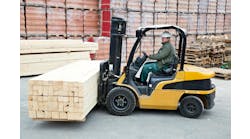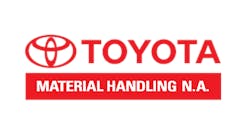ProMat Conversations: From Drone Forklifts to Mushroom Packaging
Most of the material handling and logistics innovations exhibited at last month's ProMat Expo in Chicago's McCormick Place could be described as "enabling" technologies. But if you tried hard enough you could also find yourself talking to people about disruptive technologies.
For example, Rich Sherman, author and president of Gold & Domas Research, believes one of the more disruptive technologies will make its way from retail stores and gaming arcades and into warehouses. It will combine optical imaging capture with automated search and storage capabilities. Say goodbye to lift truck operators and hello to forklift "gamers." Operators will control lift trucks remotely and use image capture to find and pick orders. Imagine the drones you've read about that are changing modern warfare and you have an idea of what he's talking about.
Aside from that, most of the discussions at the hundreds of exhibits stuck closer to addressing today's demands, focusing on the human and capital resources necessary to maintain economic health. Many of the innovations on display showed visitors who were still struggling with economic uncertainty how to get more productivity from their existing infrastructure.
John Lee, vertical marketing manager at Nilfisk Advance, was showing his company's new fuel-cell-powered floor scrubbers. The idea was to target the existing base of manufacturers and distributors that have already made a substantial investment in a hydrogen infrastructure supplied by Plug Power to support their fleets of fuel-cell-powered lift trucks.
Another example of making best use of existing resources in the industrial tuck world was demonstrated at the Hyster booth by the company's president, Jonathan Dawley. He noted that e-commerce is constantly changing the configuration of distribution environments and that calls for multi-purpose equipment. He showed a turret truck that can be used as a multi-purpose vehicle, not only as a dedicated-aisle vehicle in a dense storage system, but in other general-use applications. He also showed off new electric vehicles that can be used both indoors and outdoors.
Thom Peebles, director of brand management for NACCO Materials Handling Group, addressed flexibility of financing options, including a trend toward paying for the equipment hours you use.
At the Raymond exhibit one of that OEM's customers, Bob Simon, senior director of contract packaging at Genco, the third party logistics service provider, told MH&L about his company's new partnership with Raymond and with Easy Metrics, a labor management system provider. The goal of this relationship is to reduce costs and increase worker productivity. Genco uses Raymond's iWarehouse fleet optimization system. This combination helps Genco ensure that only trained personnel are using the equipment and at what level of productivity. It also helps the operators understand their productivity and gives them an incentive to improve.
Lift truck manufacturers also made their presence known during off-floor meetings with MH&L. Jeff Rufener, president of Toyota Material Handling, who was attending the show with members of his quality assurance and engineering staff, addressed the need for proper lift truck operator training. This can lead to a 61% improvement in operator performance scores, he says. And when you consider that a quarter of lift truck accidents are the result of inadequate training and that OSHA fines for this inadequacy can reach $70,000, it's ironic that the most important aspects of lift truck ownership are the simplest to understand and the easiest to apply.
In a separate conversation, Jim Gaskell, director of global insite products for Crown Equipment, says that many fleet managers need to get a more accurate bead on performance goals. According to his company's research, many customers think they're getting as much as 80% utilization of their fleets. Gaskell says it's more like 40-60%. The problem, he says, has to do with a combination of warehouse design and activity spikes. The remedy might be as simple as changing the work flow through the facility and paying more attention to what the operators are doing.
Back on the show floor, another hot topic was multichannel distribution. It was addressed by companies introducing products in response to the need to be flexible enough to accommodate retailers, distributors, catalog sales and online customers. These channels can be physical, digital and sometimes both. And one of the biggest challenges comes in transitioning your operation from batch to on-demand because, as Mike Khodl, VP of Dematic's solution development group, explains, "You no longer know exactly what your demand is going to be."
One of the keys is to make sure sufficient manpower is in place. No matter how sophisticated a big-box retailer's technology might be, that still doesn't guarantee store shelves will be stocked with products consumers want. To that end, Manhattan Associates is teaming up with Kronos, a provider of workforce management solutions, to help retailers execute on their multichannel strategies. As Eric Lamphier, senior director at Manhattan, points out, retailers need to get better at freeing up the inventory in their stores.
The manufacturer's role in the supply chain was also discussed at ProMat. Doug Keith, president of Siemens Industry, Drives Technology Div., believes North America is on the cusp of a manufacturing renaissance. It already represents 25% of the world's economy, he says, and between now and 2018 it will represent 20% of its total GDP growth. He adds that his company is investing $50 million a year on job training and in science, technology, industry and manufacturing education.
The role of environmental sustainability is becoming part of that education, and it, too, made its way into show floor conversations. Tim McInerney, product manager at Sealed Air Corporation, was showcasing the benefits of Restore, protective packaging material made from mycelium (the root-like structure of mushrooms). It's home compostable, so it can be taken to any of the more than 600 composting facilities in the U.S.




